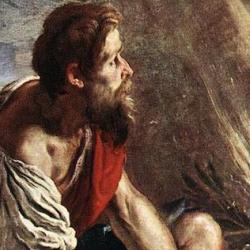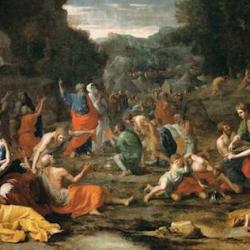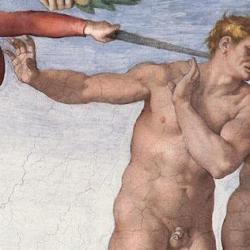Joel Humann’s Durham dissertation on Numbers 19 (the red cow and the waters of purification) is wonderfully illuminating. After a judicious close reading of the chapter, he turns to the question of the placement of the passage within Numbers.
He observes that in Numbers the wilderness becomes a place of death. Death results specifically from encroachment on the sanctuary and rebellion against God: “Death is the inevitable consequence of the sins of encroachment and rebellion against the holy God by a sinful people, who have been called to live in a holy community, in imitation of the holy God and gathered around Him who dwells in the midst of the sanctuary” (220).
Numbers records three primary narratives of rebellion, which correspond to different zones of the graded holiness system of the tabernacle. Humann summarizes:
“As the narrative unfolds, the rebellious dissent of Israel begins, in Num 11, at the very boundary between the camp of Israel and the wilderness.” When “the Israelites . . . grumble and complain about their condition in the wilderness, specifically the lack of a rich and luxurious diet as was their experience in Egypt . . . God responds to the dissent by consuming the outer boundaries of the camp with fire (Num 11.1). Increasingly the sin of the whole of Israel ‘encroaches’ upon the holy as it is both spatially and personally demarcated, beginning in the first zone, within the camp of Israel itself (Num 13–14), progressing to the second, the Levitical ‘buffer’ which separates Israel from the priestly sancta (Num 16–17), and finally the third sphere, that is the priesthood of Aaron and, indeed, Moses himself (Num 20). The homological correspondence between spatial and personal gradation of holiness thus provides the thematic framework for the progression of these rebellion narratives. The terminus of the rebellion narratives is the ultimate divine boundary—Moses and Aaron attempt to usurp the role and place reserved for the Deity alone” (221).
The polarity of death and life runs, in fact, throughout the Moses narratives of the Pentateuch. In Numbers, it is expressed spatially: The wilderness is the realm of death, the sanctuary the realm of life. When Israel rebels and violates His holiness, Yahweh breaks out in a variety of deadly ways against them (222).
Within this context, the “analogy between the ceremony of the Red Heifer and the narratives of death and encroachment which becomes manifest. Death is the ultimate impurity. It is consigned to the space at farthest remove from the holy of holies—the wilderness. For the corpse-contaminated individual to remain in the camp and wantonly neglect purification is itself a form of encroachment and thus is punishable by extirpation (karat). The ceremony negotiates between the extreme poles of graded holiness, traverses the boundary between the source of life, spatially conceived as the sanctuary, and the realm of death, relegated to the outer wilderness. The may-niddah constitute the means and medium by which individuals can be rid of the contamination of death which is consigned to the wilderness, and thereby reintegrated into the community of Israel” (225).
Corpse contamination consigns an Israelite to the death-defiled wilderness. The waters of purification purify, removing the contagion of death. Within the narrative context, though, the waters also effect a spatial movement, from outside in, from the zone of death to the zone of life, from the wilderness to the sanctuary.
As Humann puts it: “the Red Heifer as a rite of passage effects separation from a state of corpse-generated impurity. Such separation entails also spatial transfer. Among the chattat sacrifices the Red Heifer is the only instance where the slaughter and subsequent ceremony occurs ‘outside the camp’ (Num 19.3). From this locale the ceremony, as it is presented in its narrative context, thus effects a spatial transition. The corpse-contaminated individual is, by means of the may-niddah, not merely purified but spatially transferred from ‘outside’ to ‘inside’ the encampment of Israel, while those who administer the rite are thereby defiled.”
THus, “When one turns to the question of the relationship of Num 19 to its overall narrative context and the question of thematic and symbolic relationships between the two, the characterisation of the ceremony of the Red Heifer as a rite de passage also becomes significant. Narratively, the exodus from Egypt, transit through the wilderness, and entry into Canaan form an inseparable whole. The narrative highlights the ‘physical dichotomy between the wilderness as the realm of the dead versus the promised land as the site of the living'” (225-6).
The rite of passage through the water of purification follows the historical “rite of passage” from Egypt to the promised land (226-7).
But the narrative placement also links this ritual to a particular moment in the history recorded in Numbers. It’s the last of the legislation in Numbers, and symbolizes the entire movement of the book. Like the heifer, the first generation of Israel is reduced to dust in the wilderness. But the very death of the first generation makes possible a transition of a new generation into the land. The rite of purification from corpse defilement ritually sums up the history of Israel between Sinai and entry to the land.
Humann puts it this way: “It is the final liturgical law given during the era of the Sinai generation and itself thematises purification and separation from death and the wilderness. Considered merely as another rite of purification it could conceivably ‘be located almost anywhere that cultic legislation is appropriate.’ In fact, Leviticus, at first blush, seems a more appropriate literary context. But intentional juxtaposition is the key to its placement—the Red Heifer itself thematises the narrative at this point. The wilderness is ‘preeminently a place of death for Israel, which must die to be reborn.’ The heifer, as a symbol of the old generation Israel, is reduced to dust in the wilderness; by means of the ashes of the heifer and living water the one contaminated by death is restored to a living relationship with God, even as the new generation is transferred from the wilderness to the land of promise. The heifer immediately foreshadows the impending final elimination of the old generation, and symbolises the promise given to the new. ‘Future life in the land will replace the pervasiveness of death in the wilderness'” (228-9).
This also explains the seriousness of refusing to receive cleansing from corpse defilement. It’s equivalent to refusing to move from wilderness/death into the land/life. It’s another form of rebellion against the Lord, which will only intensify death and impurity.
Again Humann’s words: “The rebellion of the old generation of Israel is accompanied with their desire to abandon their destiny and return to Egypt. Their past in Egypt ‘becomes an obstacle to a successful future. Only after the death of those seduced by the Egyptian past can the next generation proceed to fulfill a future in the promised land.’ Rebellion entails a refusal to enter the promised land—a narrative analogue of the refusal to be purified, and thus maintain one’s connection and integration with the holy camp in the midst of the wilderness” (229-30).












